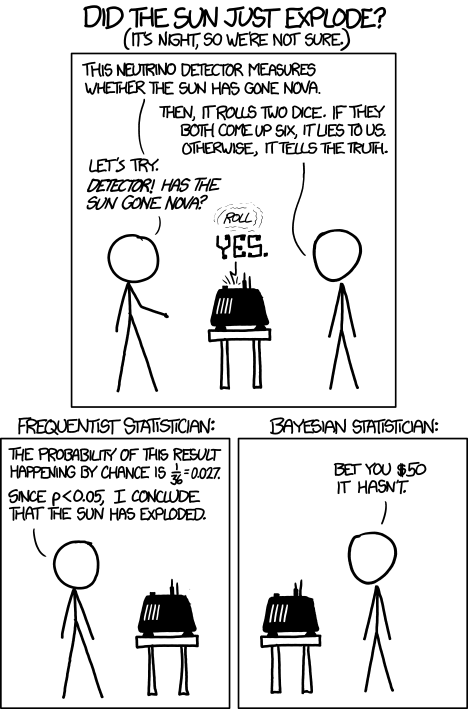We have a variety of formats for lab meeting. One of them is a lightening journal club, where each person shares one paper from an assigned journal, including one question and one comment about the paper. This allows us to get a snapshot of research that is interesting to people in the lab. By posting it here, we can also allow the space for continued discussion. I have not edited the Comments or Questions that were sent to me by the members of the lab. The "Lab Thoughts" are our brief comments from lab meeting in response to the paper/question. This is the first group of papers we discussed at lab meeting last week:
Bioinformatics
"Big data and other challenges in the quest for orthologs"
Sonnhammer et al., 2014
Comment:
It does seem, that until the computational capacities catch up to the demand that a viable temporary solution is analyzing smaller, easily-managed sets of data and compiling the results. However, this would result in a decreased confidence in the determined relationships.
Question:
To work around computational demands in sequence analysis the Similarity Matrix of Protein project (SIMAP) utilized user-volunteered computing. They have used this method for the past 10 years, but are now returning to ‘in-house’ computations; what changed that would warrant this shift? There are still high computational demands, so after 10 years what are the drawbacks of user-volunteered computing that would cause them to return to in-house computations? (pg. 2994)
Lab Thoughts:
Perhaps the computing is taking up more RAM than it was in the past. So, previously user-volunteered computers would be sufficient for the analysis, but now there is need for higher-RAM processors.
BMC Bioinformatics
"MoTeX-II: Structured MoTif extraction from large-scale datasets"Pissis, 2014
http://www.biomedcentral.com/1471-2105/15/235
Comment:I find it impressive that this tool is able to speed up current motif extraction by about 7 times.
Question: How well would this program run on a normal computer? Could it be run efficiently using the cloud?
Lab Thoughts:From the paper, "We implemented MoTeX-II in three flavors: a standard CPU version; an OpenMP version; and an MPI version. " Thus, it seems like the program can definitely run on the CPU capacity of a desktop, but there are also versions that require more computing power.
British Journal of Cancer
"Notch-induced transcription factors are predictive of survival and 5-fluorouracil response in colorectal cancer patients"
Candy et al., 2014
http://www.nature.com/bjc/journal/v109/n4/full/bjc2013431a.html
Comment:
It was interesting that atypical Notch signaling seems to be a factor in chemotherapy treatment resistance.
Question:
What is "Notch" in Notch-induced transcription factors?
Lab Thoughts: Notch refers to the phenotype that was observed when mutations in this pathway were originally detected (notches in the wings of fruit flies). More about Notch signaling pathway here: http://en.wikipedia.org/wiki/Notch_signaling_pathway
G3
"A Discovery Resource of Rare Copy Number Variations in Individuals with Autism Spectrum Disorder"
Prasad et al., 2014
Comment:
Many of the mutations in the genes came from the mother which would explain the higher prevalence of ASD in males, some were deletions and others were additions, there were similar findings paternally at a lesser degree.
Question:
Which genes overlap between females and males with ASD?
Lab Thoughts:
This paper doesn't analyze differences in risk between males and females. There is a sex-bias in risk for autism, and the paper even analyzes drastically different numbers of male and female patients (571 males and 125 females). Understanding the sex-bias in autism may help inform on potential mechanisms.
Genetics
"Bayesian inference of shared recombination hotspots between humans and chimpanzees"
Wang and Rannala, 2014
Comment:
The article concludes that there are areas on different chromosomes in both humans and chimpanzees that regularly undergo recombination – “hotspots”. Although these hotspots aren’t universal, there are many shared hotspots between the two. This relates directly to our research on X-Y recombination, as we analyze many different organisms (including humans and chimpanzees) for shared recombination areas, and this tells us that one group has already found links that we can verify.
Question:
What is the Baseyian method?
Lab Thoughts:
Bayesian refers to a type of statistical modeling. Statistics can usually take three major forms: Frequentists, Bayesians, and Likelihoodists (although some argue this is just a flavor of Bayesian statistics). A brief discussion of the difference between Bayesian and Frequentist statisticians by Hochester: http://www.quora.com/What-is-the-difference-between-Bayesian-and-frequentist-statisticians. And, an XKCD cartoon:

No comments:
Post a Comment